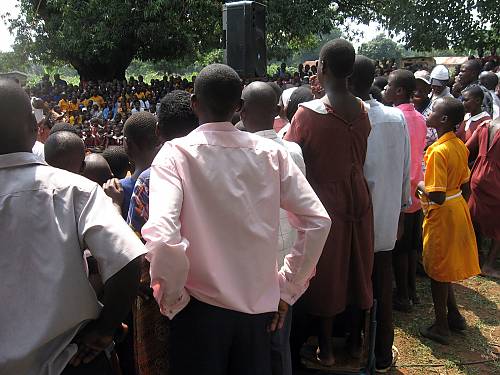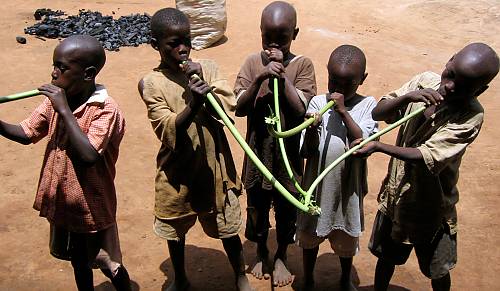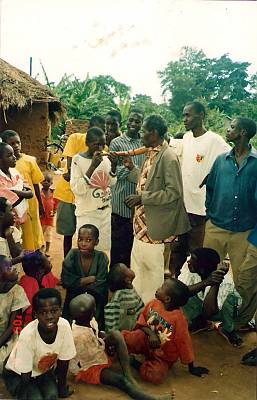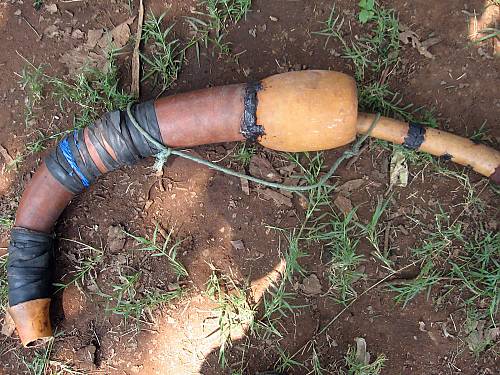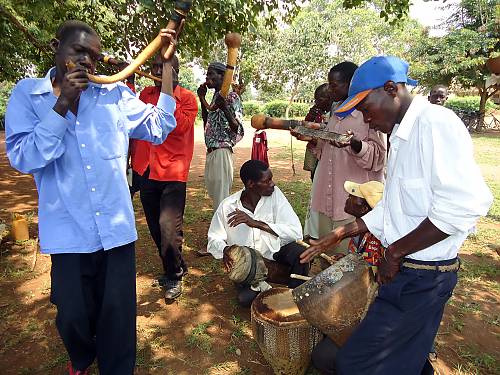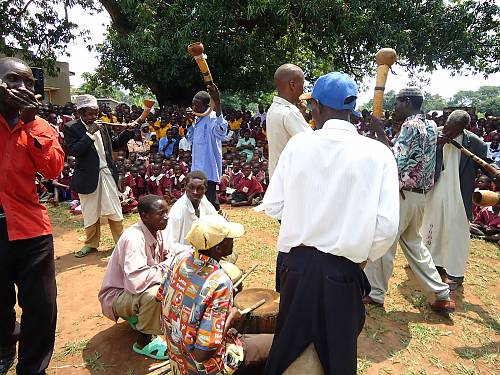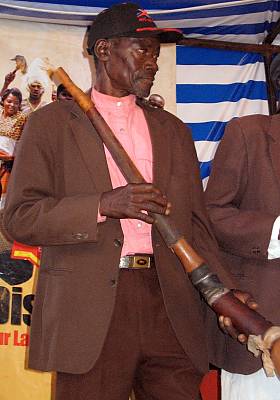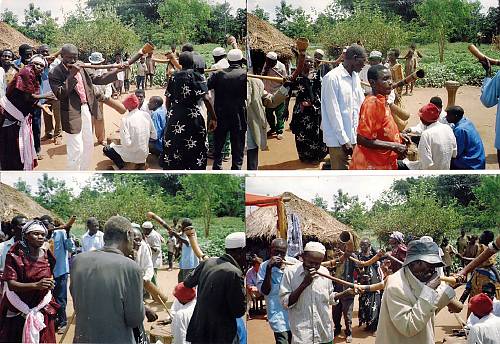Report on the status of an element inscribed on the list of intangible cultural heritage in need of urgent safeguarding
A. Cover sheet
A.1.
State Party
Name of State Party
Uganda
A.2.
Date of deposit of the instrument of ratification, acceptance, approval or accession
This information is available online.
Date of deposit of the instrument of ratification, acceptance, approval or accession
2009-05-13
A.3.
Element inscribed on the Urgent Safeguarding List that is the subject of this report
Name of element
Bigwala, gourd trumpet music and dance of the Busoga Kingdom in Uganda
Inscribed in
2012
A.4.
Reporting period covered by this report
Please indicate the period covered by this report.
Reporting period covered by this report
01-12-2012 - 30-09-2016
A.5.
Other elements inscribed on the Urgent Safeguarding List, if any
Please list all other elements from your country inscribed on the Urgent Safeguarding List, together with the year of inscription; for multinational elements, please indicate the other States concerned.
Other elements inscribed on the Urgent Safeguarding List, if any
Empaako tradition of the Batooro, Banyoro, Batuku, Batagwenda and Banyabindi of western Uganda (2013)
Koogere oral tradition of the Basongora, Banyabindi and Batooro peoples (2015)
Ma'di bowl lyre music and dance (2016)
Male-child cleansing ceremony of the Lango of central northern Uganda (2014)
A.6.
Executive summary of the report
Please provide an executive summary of the report that will allow general readers to understand the current status of the element, any positive or negative impacts of inscription, the implementation of safeguarding measures during the reporting period and their possible update for the following years.
Executive summary of the report
By the year 2012, when Bigwala Gourd trumpets Music and Dance of the Basoga kingdom in Uganda was inscribed, Bigwala was no longer performed in the communities, not played on radio or TV, youth did not know anything about the element and only five elderly men that were no longer active to perform it existed. Although the kingdom organizes many royal functions where this element should play a key role, Bigwala was only performed once in recent years for the funeral of late King Henry Wako Muloki in 2008. This problem was due to existence of very few proficient players, absence of gourds that are used to make the instruments and succession wrangles that followed king Muloki’s death among others.
Currently, Bigwala music is played on Busoga based radios; NBS (89.4 by Mudoofu), Baba FM (87.7) and Busoga1 (90.6 by Anyole). For example on NBS radio there is a call in, Sunday evening program where an average of eight people calls during the show to appreciate or ask questions about Bigwala. Also, fifty selected new players performed at the 2nd coronation anniversary of King Nadiope Gabula IV on 13th October 2016. More than 50,000 people, according to the Minister of state for Gender, Labor and Children Affairs, attended that function. Bigwala has recently been performe at ten community functions in Bugiri and Iganga districts. These are examples of viability of the element.
Seven new groups of Bigwala players including: 45 instrumentalists and 50 dancers have been created. These groups are found at Mawanga village (Bugiri district), Butyabule, Nakisenyi, Bukakaire, Nabirere and Kiwanhi villages in Iganga district plus Nakibungulya village in Kamuli district. Groups include men and women that also grow gourds used to make Bigwala. These groups were trained in Bigwala making, playing and dancing.
Before the intervention, gourds that are used to make Bigwala were not available in Busoga. After searching a few were found at Kokoi (Pallisa district), Bugema (Mbale district) and Budumba (Butalejja district). Communities were then provided with seeds and currently gourds are available in the communities.
The inscription of Bigwala caused some newspapers to feature stories about the element. For example the East African newspaper at, http://www.theeastafrican.co.ke/magazine/Busoga-dance-and-music-join-Unesco-list/-/434746/1680720/-/131wath/-/index.html and the New Vision http://www.newvision.co.ug/new_vision/news/1333991/bigwala-busoga-royal-music-dance The above newspaper reports have contributed literature about Bigwala. Various organizations posted the element on their websites for example Singing Wells at http://www.singingwells.org/preserving-threatened-heritage/. Research by Kyambogo University staff and students on the element took place. As a result, reference to that literature by other scholars has also happened. For example Kingsley Ampomah wrote an article in the European- American journal of Logistics and Supply Chain Management and made reference to Bigwala. This is accessible at: http://textlab.io/doc/404383/pages--24-31--download-pdf----european-american-journals (Page 29).
Safeguarding measures ensured quick transfer of knowledge and skills from the surviving holder to a new generation of Bigwala players. This involved distribution of gourds seeds, training youths how to make Bigwala, to play them and to dance.
The next move will focus on increasing opportunities for the new generation of Bigwala players to perform for the king and communities. We will also increase the use of radio to popularize the element in the face of pop and other related music that attracts attention of FM stations. Then we will consolidate the ownership of Bigwala heritage by the kingdom as the case was before.
A.7.
Contact person for correspondence
Provide the name, address and other contact information of the person responsible for correspondence concerning the report.
Title (Ms/Mr, etc.)
Mr
Family name
Isabirye
Given name
James
Institution/position
Executive Secretary National Council of Folklorists of Uganda (NACOFU)
Address
P.O. Box 199
Kyambogo
Telephone number
+256 782 721 506
E-mail address
nacofuorg@gmail.com
Other relevant information
B
Mr
B. Status of element inscribed on the Urgent Safeguarding List
Refer to the nomination file or to previous reports, if any, as the basis for reporting on the current status of the element, and report only on relevant changes since the date of inscription on the List or since the previous report. Nomination files, specific timetables and earlier reports, if any, are available at https://ich.unesco.org or from the Secretariat, upon request.
The State Party shall pay special attention to the role of gender and shall endeavour to ensure the widest possible participation of the communities, groups and, where applicable, individuals concerned as well as relevant non-governmental organizations during the process of preparing this report, and is asked to describe how it has done so in point D below.
B.1.
Social and cultural functions
Please explain the social and cultural functions and meanings of the element today, within and for its community, the characteristics of the bearers and practitioners, and any specific roles or categories of persons with special responsibilities towards the element, among others. Attention should be given to any relevant changes related to inscription criterion U.1 (‘the element constitutes intangible cultural heritage as defined in Article 2 of the Convention’).
Social and cultural functions
Bigwala Gourd trumpets Music and Dance of the Basoga kingdom in Uganda is performed at the Busoga King’s coronation and its annual anniversaries, funeral of a king or any of the eleven hereditary chiefs of Busoga. Bigwala is also performed at social events like house warming, last funeral rites of elders among others. On 13th September 2016, the new generation of Bigwala 45 youths played to usher King William Wilberforce Nadiope Gabula IV into the 2nd coronation anniversary ground at Bugiri, Saza headquarters ground, where a crowd of about 50,000 people joined the celebration. The Bigwala youths did not dance but only played the instruments according to the rituals of the moment. They led the king in front of their tent where he played one of the 11 drums that symbolize the 11 chiefdoms of Busoga, together the Bigwala drummers the rhythm “Mwenemu alimu” which means the king is around.
The 45 players were selected from groups that have been created in Bugiri, Kamuli and Iganga districts. They carried out two weeks joint rehearsals at Mufumi Primary School ground near Idudi trading centre. Communities around the school joined the rehearsals daily and many children, women, elders witnessed the performances of Bigwala and enjoyed them. The Chairman for Mufumi Local Council One appreciated; that his area was selected to host the Bigwala rehearsals because many people got opportunity to enjoy Bigwala Music and Dance.
The remaining bearer of Bigwala knowledge and skills James Lugolole is an elderly peasant that is barely able to fend for his family. Thanks to the UNESCO ICH fund from which wages for his training of youths were got; part of the wages was used to overhaul his house that was about to fall. Lugolole was energized by this and community members at Nabirere his home village did not only allow their children to learn Bigwala but collected seeds to plant gourds.
There are groups of Bigwala youths at seven villages including: Nabirere, Bukakaire, Butyabule, Mawanga, Kiwanhi, Nakisenyi and Nakibungulya. These villages are distributed in 3 districts. Most of the youths are peasant farmers that are involved in other small businesses for survival. Some of these are married women and men. Spouses expressed support for participation of their husbands and wives in Bigwala. Some youths are students in secondary schools. Parents and teachers are supportive of their participation in Bigwala. Asuman Walyanda the Bigwala lead trainer and a music teacher is a head teacher at Buwenge Primary School.
Honorable Richard Mafumo, Minister for culture in Busoga kingdom has the duty to follow up Bigwala for the kingdom. When the new generation of performers were preparing for the coronation anniversary, heattended their rehearsals and commissioned the official uniform for the Bigwala players in the kingdom. These were designed with advice from Lugolole James, the main reference for the Bigwala safeguarding project.
B.2.
Assessment of its viability and current risks
Please describe the current level of viability of the element, particularly the frequency and extent of its practice, the strength of traditional modes of transmission, the demographics of practitioners and audiences and its sustainability. Please also identify and describe the threats, if any, to the element's continued transmission and enactment and describe the severity and immediacy of such threats, giving particular attention to any strengthening or weakening of the element’s viability subsequent to inscription.
Assessment of its viability and current risks
Currently groups are in process of learning Bigwala songs and dance in their villages. This is done at least twice a week where community members of all gender and social positions gather to watch and at times participate in practices. NACOFU has provided recordings to Busoga based NBS, Busoga1 and Baba FM radio stations to play Bigwala music every week during their cultural programs. Some of these programs involve public phone in calls that make the transmission of Bigwala knowledge participatory. This has endeared the element to radio presenters. Also the coronation anniversary coverage by these radio stations viability of Bigwala music and dance. Therefore, for the last one year, there has been increasing interest and exchange of knowledge and skills about Bigwala music and dance among the Basoga communities either by word of mouth or radio. Thus, viability of this element is increasing.
There are many music groups in Busoga that play various musical instruments and perform dances. These groups hold regular practices and some youths who learnt Bigwala music and dance perform in those groups for example Muwewesi xylophone group at Nakisenyi village. Groups assemble in their centers to practice Bigwala music and dance and later their other music styles that they perform at functions and vice versa. This helps the practice of Bigwala to continue within the existing music performers’ infrastructure. In addition to that, most of the Bigwala youths are also musicians that train children in schools. They are planning to include Bigwala music and dance in theor items.
After the death of Henry Wako Muloki in 2008, succession wrangles caused Busoga to be without a king until 2014 when this problem was settled. Therefore, the awaited election of a successor triggered new love for the Busoga cultural institution and every element associated with it. As a result many youths are involved in various activities to identify with the new youthful king. Consequently, those that are exposed to Bigwala practice do it with a passion for the kingdom. The kingdom leadership on the other hand is investing in branding itself as a kingdom for the youths and ready to organize activities for them. For example, the king launched a football tournament among the chiefdoms of Busoga mainly to associate himself with youths. Therefore, Bigwala practice will enjoy the welcoming attitude both from the new generation of youths who perform it and kingdom leadership who constitute the main audience. In addition, the state has not witnessed any enactments that could threaten the viability of Bigwala music and dance since its inscription.
B.3.
Implementation of safeguarding measures
Please report on the safeguarding measures described in the nomination file, and previous report, if any. Describe how they have been implemented and how they have substantially contributed to the safeguarding of the element during the reporting period, taking note of external or internal constraints such as limited resources. Include, in particular, information on the measures taken to ensure the viability of the element by enabling the community to continue to practise and transmit it. Include the following detailed information concerning the implementation of the set of safeguarding measures or safeguarding plan:
B.3.a.
Objectives and results
Indicate what primary objective(s) were addressed and what concrete results were attained during the reporting period.
Objectives and results
The main objectives included:
1. Carry out capcity building workshops for youths and teachers in Bigwala making, playing and dancing.
2. To develop better documentation. Photographs, audio and video documents of Bigwala.
4. To hold the Bigwala festival and raise awareness.
5. To set an example for other Ugandan societies to participate in safeguarding of their heritage.
Main results:
Bigwala communities were created in 7 villages located in three districts. These include Butyabule, Nakisenyi, Bukakaire, Nabirere and Kiwanhi in Iganga district, Nakibungulya in Kamuli district and Mawanga in Bugiri district. It is those villages that a total of 31 workshops in Bigwala making were done where 67 participants were trained to make. Also, 33 workshops in Bigwala playing were done and 102 instrumentalists were trained. 21 workshops for Bigwala dancing have so far been done and 108 dancers have been trained. These figures so far exceed expectation. Some participants that were identified to be very good performed at the coronation anniversary of king Wilberforce Nadiope Gabula IV at Bugiri town on 13th October 2016.
Photographs, Audio files and DVDs of Bigwala safe guarding activities are being made by NACOFU and her partners as well as individual members of the community. NACOFU has materials from selected workshops covering all seven Bigwala communities that were created. These materials have been and will continue to be accessible to the communities, general public, kingdom officials, radio and television houses. Some were done by Singing Wells and are accessible at www.singingwells.org/stories/central-and-eastern-uganda-day-2-kampala-to-jinja/
The Bigwala festival will be held in 2017 and will planned with Busoga kingdom officials and the king is expected to officiate. Prizes will be given to outstanding players. Business coporates will be attracted to participate in it so that it will become an annual event.
During the festival exhibtions of some Bigwala photographs, CDs and DVDs will take place.
Bigwala project is now a model that is being used to safeguard Kimasa (Royal harp) of Busoga kingdom, Entenga (tuned drums), Endere (flute band), Entamivu (xylophone with drums band) and Amakondere (royal trumpets band) music of Buganda kingdom by NACOFU. This has also attracted a SOAS Masters of Ethnomusicology student (Basile Koechlin) to carry out research about the revival of Entenga royal drums of Buganda kingdom.
The project has awakened enthusiasm among community members, NACOFU officials and teachers. Community members grew gourds that are used to make Bigwala and have earned money from selling them. James Lugolole, the master player got his house renovated from the wages he earned. This has changed lives of members in his family. As a result youths in his neighbourhood are enthused about Bigwala since from it their neighbour’s life has changed. Lugolole then observed that, “I am so happy. I feel now, when I finally die, I will have a hand that has reached back, teaching others the trumpets so the music lives beyond me.”
B.3.b.
Safeguarding activities
List the key activities that were carried out during this reporting period in order to achieve these expected results. Please describe the activities in detail and note their effectiveness or any problems encountered in implementing them.
Safeguarding activities
i. Set up a Project Management Committee (PMC)
II. Encourage communities to grow gourds / buy them
III. Teach youths to make Bigwala
IV. Teach youths to play Bigwala and Forming Bigwala groups
V. Teach youths to dance to Bigwala Music
VI. Document in photographs, audio files and videos
VII. Publicizing Bigwala Music and Dance and the
VIII. Monitoring
Activities included:
The Project Management Committee was set up to decide the course of actions NACOFU, stakeholders and communities were to follow in the safeguarding process. The committee includes members from different stakeholders and this allows the project to benefit from diverse experiences and talents of members on the committee.
At the beginning of the project, gourds that are used to make Bigwala were no longer available in Busoga. It took two months search then we found a lady in Kokoi – Pallisa, Teso (about 200 Kilometers East of Iganga) that had kept long gourds in her house. We bought and used them as the parent gourd. We encouraged members in seven villages – turned into Bigwala communities, to grow the gourds. Seeds were given to a few people and when they harvested we got more seeds that we distributed to everyone that was interested among the communities and taught them how to care for the crops. The project offered a high price as an incentive for the first crop from the communities. The gourds are currently abundant among the communities.
The first crops of gourds were used in workshops to teach youths to make Bigwala at various places in Iganga, Bugiri and Kamuli districts.
Workshops to teach youths to make Bigwala happened first. Some participants learnt quickly and were used by the master players and activity leaders to help more youths learn how to make.
Then workshops for Bigwala playing happened. Blowing the Bigwala was quite challenging and some youths had fears that their mouths would crack. Currently there are seven youth groups each with ten and more players of the Bigwala plus another 5 that play drums. Youths were then taught to dance to Bigwala music authentically. This was easier because the Bigwala dance has similar motifs to other dances in Busoga.
As the project went on, elders that have knowledge about Bigwala heritage showed up and kept on playing leaders’ roles during the activities. Also, whenever youths play, some elders gather and during time of rest, they share with the youths, their past experiences about Bigwala.
These conversations have been documented in audio and audio-visual formats and lead participants photographed for reference. The project has attracted interested and experienced partners to document and publicize the state of Bigwala. For example Singing Wells documented Bigwala youths and published on their website at www.singingwells.org/stories/central-and-eastern-uganda-day-2-kampala-to-jinja/ that is accessed mainly by youths.
The project engaged three FM radio stations based in Busoga including NBS, Busoga1 and Baba FM stations. These have culture programs that have aired project activities, locations of Bigwala communities so far, testimonies of project participants and answered questions of listeners. This helped to disseminate information about Bigwala and the project and have encouraged youths to phone in and ask for clarifications. This has increased knowledge about and interest in the element among the communities.
Information about Bigwala was submitted to the editors of the 2nd anniversary coronation magazine and they included it in the publication. This increased dissemination of information about Bigwala and the project. Bigwala is the only cultural symbol that was written about in detail with recent photographs of youths playing Bigwala in that magazine.
Opportunities for youths to play Bigwala have started and this will increase awareness about Bigwala and raise community interest in the element, particularly youths. Aslo, during that coronation anniversary played drums with the Bigwala youths at their tent. This symbolized the importance of Bigwala and created interest among the youths that saw this act.
The safeguarding experience faced some problems. The search for gourds was the biggest challenge. This was overcome by the hard work of three leading community members including: James Mukama, Godfrey Mugabe and Irene Nabirye that carried out house to house search through Busoga communities until all clues were exhausted. They travelled to Buganda, Bunyoro and finally Teso where one lead enabled them solve the problem. Financial resources were limited but the determination of the communities about this element has played a great role the realization of project benefits.
B.3.c.
Participation of communities, groups or individuals in the safeguarding activities
Describe how communities, groups or, if appropriate, individuals as well as relevant non-governmental organizations have effectively participated, including in terms of gender roles, in the safeguarding measures. Describe the role of the implementing organization or body (name, background, etc.) and the human resources that were available for implementing safeguarding activities.
Participation of communities, groups or individuals in the safeguarding activities
Communities have been involved in planning interventions at the Project management committee level. The project management committee which is responsible for streamlining and monitoring the actions of the project includes members from the communities. These are Walusimbi Haruna, the Director of Nile Beat Artists, one of the cultural groups that are involved in the safeguarding actions. He is the Bigwala Project Manager. He lives near the Bigwala communities and can reach them any time and has capacity to communicate with the Project Leader. Other Bigwala community members on the committee include: the Chairperson of Namalemba Sub-County Local Council, James Lugolole, the surviving Bigwala master player, Nabirye Irene from Mawanga and Godfrey Mugabe, the Bigwala youths group leader from Bukakaire village. Iganga District Community Development Officer in charge of culture is member of the project management committee. These members generate ideas that inform the actions of the Bigwala project. Some of these members have been involved right from the time of preparing the nomination files.
Communities have participated actively in implementation of activities in different ways such as:
Local Council Leaders have been helpful in mobilizing new Bigwala groups, encouraging people in their villages to grow gourds and speaking strongly about the need to revive not only Bigwala but all endangered cultural idioms of Busoga. In some places, for example in Buwunga Sub County, the Speaker of the Local Council Rev. Magoola promised to include financial support to the Bigwala youth group at Mawanga village in their budget for the next financial year and encouraged members in their community to support this cause. The Sub County representative to Bugiri District Council, Mrs. Bajje offered to become the Patron of that Bigwala group.
New Bigwala groups are growing gourds, seeking guidance on how to care for their crop and make Bigwala out of them. They invite resourceful people in their villages for our meetings / workshops to ensure that their immediate Bigwala community comprises skilled people. This has led to an encouragingly big turn up of men, women, schooling and non-schooling children of all ages, at the Bigwala workshops.
James Mukama, Godfrey Mugabe, Irene Nabirye and other youths searched for seeds up to distant places like Bunyoro, Buganda and Teso other areas that are more than 150 Kilometers away. They went through villages asking from house to house until they found some gourds in Pallisa district. It is these gourds that gave seeds for a new generation of Bigwala gourds.
James Lugolole and the 15 Bigwala youths have moved places encouraging new Bigwala groups, and always talked about the media and international attention they have received so far. Bigwala has been covered by Ugandan (The New Vision and Monitor newspapers), regional (The East African newspaper) and international media like BBC plus Singing Wells; a partner music organization with NACOFU. Bigwala communities always assemble whenever called upon to meet any persons interested in this project thus contributing to further dissemination of the Bigwala cause.
B.3.d.
Timetable and budget
Indicate in a timetable when each activity was implemented and the funds that were used for its implementation, identifying the source of funding for each (governmental sources, in-kind community inputs, etc.).
Timetable and budget
Set up a Project Management Committee (PMC) - Month 1 (USD 300 - Uganda Government)
• Send out invitations for Namalemba Sub-County Headquarter meeting
• Arrange venue and refreshments
• PMC meeting chaired by Namlemba Local leader
• PMC visited Lugolole’s home at Nabirere village
• PMC visited 15 youths that started Bigwala playing at Bukakaire village
Encourage communities to grow gourds/ buy them - Month 1 – 7 (USD 5700 - ICH Fund)
• Community members searched gourds touring places in Busoga and beyond
• Distributed seeds at Bukakaire, Nabitende, Mawanga, Butyabule, Nakisenyi, Nakibungulya and Kiwanhi villages and Guide farmers how to grow gourds
• Visited farmers to monitor progress
• Bought gourds from farmers
Teaching youths to make Bigwala – Month 1 – 9 (USD 40 - Uganda Government + USD 2022 - ICH Fund)
• Identified village leaders to coordinate Bigwala communities
• Selection of 30 youth trainees
• Drew time table for Lugolole, Mukama and Waiswa workshops in different villages
• Communicated time table to all parties involved
• Village leaders organized venues, tents, invited village members, village leaders and refreshments
• Total of 31 Workshops held at Bukakaire, Nabirere, Butyabule, Kiwanhi, Mawanga, Nakibungulya and Nakisenyi villages
Teaching youths to play Bigwala and Forming Bigwala groups – Month 1 – 12 (USD 40 - Uganda Government + USD 10,384 - ICH Fund
• Selected 90 Youths for workshops
• Drew time table for Lugolole, Mukama and Waiswa plus music teachers workshops in different villages
• Communicated time table to all parties involved
• Village leaders organized venues, tents, invited village members, village leaders and refreshments
• Total of 33 Workshops held at Bukakaire, Nabirere, Butyabule, Kiwanhi, Mawanga, Nakibungulya, Nabirere and Nakisenyi villages
• Held month long joint rehearsal at Mufumi Primary School preparing for Kyambazinga’s 2nd coronation anniversary
Teaching youths to dance to Bigwala music – Month 1 – 12 (USD 40 - Uganda Government + USD 6,379 - ICH Fund)
• Selected 90 Youths for dance workshops
• Drew time table for Lugolole, Mukama and Waiswa workshops in different villages
• Communicated time table to all parties involved
• Village leaders organized venues, tents, invited village members, village leaders and refreshments
• Total of 21 Workshops held at Bukakaire, Nabirere, Butyabule, Kiwanhi, Mawanga, Nakibungulya and Nakisenyi villages
Document in photographs, audio files and videos – Month 1 – 12 (USD 900 - NACOFU & her Partners)
• Took photographs of activities
• Recorded audio formats of key activities
• Recorded videos of key activities
• Wrote down and drew sketches of some materials and activites
Publicizing Bigwala Music and Dance and the Project – Month 1 – 12 (USD 460 - NACOFU
• Radio programs on Busoga based NBS, Baba FM and Busoga 1 stations; Bigwala music played and information about element given
• New Vision and Monitor News Papers to featured articles about Bigwala
• Article about Bigwala included in the King’s 2nd coronation anniversary magazine
Monitoring – Month 6 (USD 348 - Uganda Government)
• Iganga District Community Development Officer (IDCDO) led team to monitor randomly selected project area
• IDCDO’s team prepared report with recommendations
B.3.e.
Overall effectiveness of the safeguarding activities
Provide an overall assessment of the effectiveness of the activities undertaken to achieve the expected results and of the efficiency of the use of funds for implementing the activities. Please indicate how the activities contributed to achieving the results and whether other activities could have contributed better to achieving the same results. Also indicate whether the same results could have been achieved with less funding, whether the human resources available were appropriate and whether communities, groups and individuals could have been better involved.
Overall effectiveness of the safeguarding activities
Effectiveness of activities done to achieve the results
The project management committee set up was effective because they met and gave direction the project in September 2015, members recieve up dates about the project progress to which they gave suggestions for subsequent actions immediately. They also work in smaller teams to monitor and sent out reports with photographs and other illustrations to the the rest of the members.
Teaching youths to make Bigwala was effective because after the first session workshops, two outstanding participants helped the surviving holder; James Lugolole. Currently, the number of youths able to make Bigwala and teach others to do the same far exceeds the planned 30. However, some youths still find difficulty in tuning the Bigwala, but James Mukama and Waiswa always go out to fine tune.
Teaching youths to play Bigwala was succesful. Many youths wanted to play during the King’s 2nd coronation anniversary on 12th September 2016 at Bugiri but only 45 were invited. It was challenging to select the 45 because this is a small number. The project planned 90 but currently there 102 and excitement is high.
Teaching youths to dance to Bigwala music was successful because the project planned for 90 but have realized 108 boys and girls that learnt to dance Bigwala. This was eased by the fact that the dance has motifs that are in other Basoga dances.
Research about Bigwala continued effectively because during workshops, many elders shared their experiences in group discussions. This gave vital information not only for the implementation of the project but also writings that the project is expect to generate.
Document in photographs, audio files and videos was done and materials are being used.
Encouraging communities to grow gourds was succesful because currently they are easily available among the communities.
Radio programs on Busoga based NBS, Baba FM and Busoga1 stations were succesful because 3/4 of the sampled people talk about hearing information on radio. Writing article about Bigwala in King's 2nd coronation anniversary magazine added to the publicity of the project and showed the status of this heriatge in the kingdom. Attracting partners to document and publicize state of project for example Singing Wells provided information that is accessed to some youths in urban areas as well as the press.
Creating opportunities for youths to play Bigwala is an ongoing activity that partly involved the kingdom and communities. The kingdom invited the players and communities always attended training sessions. Mawanga group have given testimony of increase in number of their performances due to Bigwala.
Use of funds for all activities involved routine processing. All Bigwala communities identified leaders that worked hand in hand with the Project Manager to generate realistic budgets for their activities. Budgets were forwarded to the Project Leader who worked with the Accounts assistant to avail the funds that were always given out on Monday or Friday in case they were refunds. Also, budget lines were given to the project manager to guide communities with and this helped in controlling use of funds.
If the gourds had been available in Busoga, the cost of making gourds could have been cheaper and sooner realized.
Different individuals participated in the project due to their knowledge, ability or position that could contribute to its success. The project was a product of the communities and their enthusiastic participation was noted.
C
Isabirye
C. Update of the safeguarding measures
C.1.
Updated safeguarding plan
Please provide an update of the safeguarding plan included in the nomination file or in the previous report. In particular provide detailed information as follows:
- a. What primary objective(s) will be addressed and what concrete results will be expected?
- b. What are the key activities to be carried out in order to achieve these expected results? Describe the activities in detail and in their best sequence, addressing their feasibility.
- c. How will the State(s) Party(ies) concerned support the implementation of the updated safeguarding plan?
Updated safeguarding plan
Overall objective is to Tag Bigwala Music and Dance Performance to the Basoga peoples’ community life, to the kingdom rituals as it were and the broader Ugandan and International Community. This will be realized by:
- Improving proficiency of youths and increasing repertoire of Bigwala songs
- Resuming the performance of Bigwala in Busoga Kingdom ceremonies
- Creating more opportunities for Bigwala groups to be hired for public performances
- Continue documentation of Bigwala music and dance and project activities
- Continue publicity for Bigwala and project on FM radios
- Preparation of Bigwala educational resources for music teachers
- Project monitoring and evaluation
Proficiency among Bigwala players will involve music teachers training the groups so that they fine tune the performances. Experienced musicians in the community will be involve in training youth groups that have been created and more others that will be formed. Also the Bigwala song repertoires of the groups will be increased to enable them perform effectively at different functions. Since there are no restrictions on public performance of Bigwala, the project will create more opportunities for Bigwala youths to Perform by creating awareness among Basoga and other urban people interested in folk music and dance entertainment to opt for Bigwala
There are arrangements with the Busoga Kingdom Minister in charge of Culture Ow. Richard Mafumo, to hold an event for the king in his palace, where Bigwala will played for him without any other activities. This will become an annual event since the kingdom minister for culture expressed the resolve of the kingdom to take Bigwala music and dance performance back into the palace to perform as they had been doing in the past.
The project will hold the Bigwala festival where the king is expected to officiate. There will be more folk music idioms mainly to make the event more exciting. Transport, refreshments, prizes for Bigwala groups, attractive venue, raised stage, security police and publicity for the event will be done. The project is creating new networks among local coporates and these, it is hoped, will contributefunding and make the festival free entry to public. This will culminate into an annual Bigwala festival.
Audio and video recording for refined, well prepared performances of Bigwala music and dance will be done. This material will be for airing on radios and TV. Photographs have been taken that will be used in publication and at the festival for display.
The project will continue the radios shows and towards the festival some TV shows about the project will be aired. Bigwala information has been put on facebook and other social platforms will be used. These are very popular among youths.
The process of writing a Bigwala teaching manual where Kyambogo University staff and students will play is planned to start by February 2017. After that, teachers will be encouraged to teach Bigwala making, playing and dancing.
The State will participate by facilitating the Ministry of Gender, Labour and Social Development staff that were identified to participate in this project to monitor the progress and make recommendations. The State will also provide security police and other government officials like Local Council leaders. These representatives of the state will also participate in festivals as guests, officials among others.
Time table: Appendix 1 attached
Budget: appendix 2 attached
C.2.
Community participation
Please describe how communities, groups and individuals, as well as relevant non-governmental organizations have been involved, including in terms of gender roles, in updating the safeguarding plan, and how they will be involved in its implementation.
00164
Community participation
A Project Management Committee comprised different actors that had specific functions. They included:
Mr. James Isabirye (NACOFU / Project Leader)
Mr. Byakika Balikoowa (Local Council III, Namalemba Sub – County)
Mr. James Lugolole (Bigwala Master Player)
Ms. Cecilia Ajom (Culture Officer in the Ministry of Gender, Labour and Social Development)
Mr. Opio Enagu (Iganga District Community Development Officer (In charge of culture)
Mr. Mafumo Richard (Culture Minister of Busoga Kingdom)
Mrs. Edith Mbedha Buyinza ( Lecturer - Performing Arts Department – Kyambogo University)
Haruna Walusimbi - Director, Nile Beat Artists Cultural Troupe, Busoga – Project Manager
Asuman Walyanda – Music Teacher (Buwenge near Jinja)
Irene Nabirye – Ekidhatobona Mawanga Cultural Group.
Representative from Uganda National Commission for UNESCO
Busoga Kingdom pledged to involve Bigwala performances where ever the king has public ceremonies like coronation anniversaries and others.
The surviving Bigwala player and music teachers offered teach youths how to play Bigwala proficiently and dance.
Five village leaders represented by Godfrey Mugabe pledged to grow more gourds and encourage more youths learn to make and play Bigwala.
Local council leaders in the different Bigwala communities pledged to continue mobilizing youths to perform Bigwala and to attend all events
NACOFU coordinated all actors at their levels, kept recorded materials, offered technical/ managerial guidance, prepared and disseminate project reports that influenced this update.
Kyambogo University Performing Arts Department and Music Teachers generated options on writing a manual which other music teachers will use to teach Bigwala. They pledged to actively participate in this exercise.
Village music group leaders pledged to mobilize communities to grow gourds, make many sets of Bigwala, participate in the competitions and share their experiences with others.
Uganda National Commission for UNESCO (UNATCOM) staff have provided useful literature and offered technical guidance to the project management. They will continue to support the project in this manner.
The Ministry of Gender, Labour and Social Development's Department of Culture will contribute to necessary resources and deploy technical staff to monitor and advise the project management on technical issues of ICH safeguarding.
Busoga based NBS, Busoga1 and Baba FM radio stations will continue to host programmes that will disseminate information about Bigwala and the project.
Some local corporates will participate in the Bigwala festival and in some cases make contributions towards the budgets.
Participation of women has been and will continue to be of great importance. On the management committee, there are three women. Among the players there were some girls and women. A majority of the youths trained to dance were girls and more will be encouraged. For example Irene Nabirye pledged to continue growing gourds, lead the Bigwala community at Mawanga and facilitating workshops whenever called upon. Many women pledged to continue supporting their spouses whenever they go to play Bigwala since they earned money to help their families.
Communities, NACOFU and Busoga kingdom will follow up evaluation recommendations after and ensure the project benefits are sustained and spread to all parts of Busoga and affect Uganda as a whole.
C.3.
Institutional context
Please report on the institutional context for the local management and safeguarding of the element inscribed on the Urgent Safeguarding List, including:
- a. the competent body(ies) involved in its management and/or safeguarding;
- b. the organization(s) of the community or group concerned with the element and its safeguarding.
2009-05-13
Institutional context
NACOFU will be responsible for implementing the project. NACOFU is registered with the NGO Board of Uganda, Ref. S. 5914/4523 and incorporated as a legal entity, Ref. No. 113787.
NACOFU mission is, “to further activities that cause Ugandan Folklores to be well identified, represented and appreciated, documented and transmitted, studied and developed in time and space for posterity and to contribute to development of their holders and those that experience them”.
NACOFU vision is, “Ugandan Folklore that are alive to contribute to solving the social, cultural, political and economic needs of the individuals and societies that hold and experience them”.
The Basoga people are the concerned community. They are about 3.1 million, predominantly peasant subsistence agricultural Bantu, that are organized under a kingdom headed by the Kyabazinga. They live in rural villages and are still faced with poverty; with families barely able to provide sufficient food and other basic needs.
D
James
D. Participation of communities in preparing this report
Describe the measures taken to ensure the widest possible participation of the communities, groups and, where applicable, individuals concerned as well as relevant non-governmental organizations during the process of preparing this report.
Participation of communities in preparing this report
Interviews with the surviving holder, Bigwala youth's leaders, Culture Minister of Busoga, Local Council leaders, elders and Focused group discussions at various Bigwala meetings and workshops were conducted to establish what had been achieved and what different people thought needed to be done in order to realize the best possible results. Workshops attracted many non registered participants and we often encouraged them to give perspectives about project activities they witnessed. All those perspectives were recorded and commonly featured perspectives have been captured in this report.
We also had radio programmes that involved public phone-ins where callers indicated knowledge and skills gaps that needed to be addressed as well as additional information about Bigwala that was helpful in monitoring the project and deciding on the best I next possible courses of action.
Members of the Project Management Committee gave their proposals, comments and most featured perspectives particularly have been included. Project monitoring was done by various people and their recommendations were compared. Reports were shared among the people and comments from stakeholders and crosscutting perspectives have been included in the report.
E
Executive Secretary
National Council of Folklorists of Uganda (NACOFU)
E. Signature on behalf of the State Party
The report should be signed by an official empowered to do so on behalf of the State, and should include his or her name, title and the date of submission.
Name
Mr. Pius Bigirimana
Title
Permanent Secretary, Ministry of Gender, Labour and Social Development
Date
14-11-2016
Signature
Upload signed version in PDF

